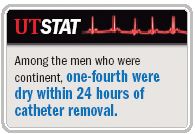Article
Robotic radical prostatectomy: Solid cancer control, functional outcomes
An analysis of experience with nerve-sparing robot-assisted radical prostatectomy (RARP) in more than 2,600 men having up to 5.5 years of follow-up indicates that the procedure provides good cancer control and functional outcomes that are comparable to those achieved with open surgery.

Keypoints:

RARP was first performed at the Vattikuti Urology Institute in 2000, and the next year it was introduced for routine surgical care of men with localized prostate cancer. Between March 2001 and September 2006, 2,652 men underwent the Vattikuti Institute Prostatectomy (VIP). Although a large proportion of those patients traveled from other geographic regions for the procedure and were being followed locally by their referring urologist, complete follow-up data were available for 1,142 patients who had between 12 and 66 months of follow-up (median, 36 months).

"While our VIP technique continues to evolve, our experience indicates RARP should no longer be designated as experimental. Furthermore, it should alleviate concerns that use of a somewhat aggressive nerve-sparing approach compromises our ability to achieve cancer control. Although biochemical recurrence at 5 years is only a surrogate measure, our oncological outcome appears to be at least as good and perhaps even superior to what has been reported for open surgery during the same period of follow-up."
Preserving potency
Men are generally considered for the VIP if they have nonfocal Gleason 6-9 cancer. Men with more than 25% Gleason 7 disease undergo conventional nerve sparing on the ipsilateral side. Otherwise, the veil nerve-sparing procedure is performed.
The nerve-sparing VIP technique has been modified in several ways since the procedure was first performed. In its most recent iteration, it involves early transsection of the bladder neck, preservation of the prostatic fascia (veil of Aphrodite), and control of the dorsal vein complex after dissection of the prostatic apex.
"Robotic surgery offers an advantage of inherent precision that has enabled our development of enhanced techniques to preserve potency after radical prostatectomy. In our series, we found return of potency was significantly better in men who had a bilateral veil procedure relative to those who had conventional nerve-sparing surgery," Dr. Menon explained.
The 2,652 men in the series ranged in age from 39 to 80 years old (mean, 60 years). More than three-fourths of the patients had clinical stage T1c disease, and, with a few exceptions, the rest were clinical stage T2a/b. Pathologic stage was T2a-c in about three-fourths of the men, and T3a/b in about 22%. The pathologic Gleason score was ≥7 in about two-thirds of the men.
"Those data reflect our philosophy of offering active surveillance to men with lower PSA levels and focal Gleason 6 cancer and demonstrates that the men in our series have higher-grade disease than in many contemporary studies of radical prostatectomy outcomes," Dr. Menon said.
















